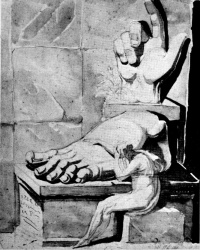Neo-classical painting
From The Art and Popular Culture Encyclopedia
| Revision as of 14:28, 25 June 2010 Jahsonic (Talk | contribs) ← Previous diff |
Revision as of 14:31, 25 June 2010 Jahsonic (Talk | contribs) Next diff → |
||
| Line 4: | Line 4: | ||
| :''[[Neo-classical]], [[painting]]'' | :''[[Neo-classical]], [[painting]]'' | ||
| - | In the [[visual art]]s the European movement called "neoclassicism" began after [[1765]], as a reaction against both the surviving [[Baroque]] and [[Rococo]] styles, and as a desire to return to the perceived "purity" of the arts of [[Ancient Rome|Rome]], the more vague perception ("ideal") of [[Ancient Greece|Ancient Greek]] arts, and, to a lesser extent, 16th century [[Renaissance|Renaissance Classicism]]. | + | '''Neo-classical painting''' was a [[European art movement]] which began after [[1765]], as a reaction against both the surviving [[Baroque]] and [[Rococo]] styles, and as a desire to return to the perceived "purity" of the arts of [[Ancient Rome|Rome]], the more vague perception ("ideal") of [[Ancient Greece|Ancient Greek]] arts, and, to a lesser extent, 16th century [[Renaissance|Renaissance Classicism]]. |
| Contrasting with the [[Baroque]] and the [[Rococo]], Neo-classical paintings are devoid of pastel colors and haziness; instead, they have sharp colors with [[Chiaroscuro]]. In the case of Neo-classicism in France, a prime example is [[Jacques Louis David]] whose paintings often use Greek elements to extol the [[French Revolution]]'s virtues (state before family). | Contrasting with the [[Baroque]] and the [[Rococo]], Neo-classical paintings are devoid of pastel colors and haziness; instead, they have sharp colors with [[Chiaroscuro]]. In the case of Neo-classicism in France, a prime example is [[Jacques Louis David]] whose paintings often use Greek elements to extol the [[French Revolution]]'s virtues (state before family). | ||
Revision as of 14:31, 25 June 2010
|
Related e |
|
Featured: |
Neo-classical painting was a European art movement which began after 1765, as a reaction against both the surviving Baroque and Rococo styles, and as a desire to return to the perceived "purity" of the arts of Rome, the more vague perception ("ideal") of Ancient Greek arts, and, to a lesser extent, 16th century Renaissance Classicism.
Contrasting with the Baroque and the Rococo, Neo-classical paintings are devoid of pastel colors and haziness; instead, they have sharp colors with Chiaroscuro. In the case of Neo-classicism in France, a prime example is Jacques Louis David whose paintings often use Greek elements to extol the French Revolution's virtues (state before family).
Technique
Oath of the Horatii shows the neoclassical painting style, and employs various techniques that were typical for it:
- The background is de-emphasized, while the figures in the foreground are emphasized to show their importance.
- The use of dull colors is to show the importance of the story behind the painting over the painting itself.
- The picture is clearly organized, depicting the symbolism of the number three and of the moment itself.
- The focus on clear, hard details and the lack of use of the more wispy brushstrokes preferred by Rococo art.
- The brushstrokes are invisible, to show that the painting is more important compared to the artist
- The men are all depicted with straight lines mirroring the columns in the background signifying their rigidity and strength while the women are all curved like the arches which are held up by the columns.
- The use of straight lines to depict strength is also demonstrated in the swords, two of which are curved while one is straight foreshadowing that only one brother would survive the encounter.
- The brother closest to the viewer (presumably destined to be the sole survivor) is dressed in colors matching that of the father while the garb of the other brothers is obscured but seems to mimic the colors being worn by the women.
- The frozen quality of the painting is also intended to emphasize rationality, unlike the Rococo style.
- The only emotion shown is from the women, who were allowed to feel, while it was for the men to do their duty with heroic determination.
- The fact that it also depicts a morally complex or disturbing story lends to its classification as a neoclassical work.
See also


